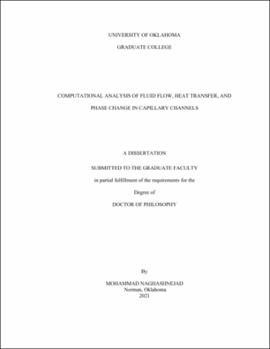| dc.contributor.advisor | Shabgard, Hamidreza | |
| dc.contributor.author | Naghashnejad, Mohammad | |
| dc.date.accessioned | 2021-08-05T20:58:44Z | |
| dc.date.available | 2021-08-05T20:58:44Z | |
| dc.date.issued | 2021-08 | |
| dc.identifier.uri | https://hdl.handle.net/11244/330233 | |
| dc.description.abstract | The fluid mechanics and heat transfer associated with capillary-driven flows are of great interest for modeling transport phenomena in micro/miniature devices. Currently, a deeper understanding of this area is necessary for the design of more effective products. The primary objective of this dissertation is to develop a novel computational fluid dynamics model to study the dynamics of meniscus formation, capillary flow, heat transfer, and phase change between vertical parallel plates. To do so, an arbitrary Lagrangian-Eulerian (ALE) approach is employed to predict and reconstruct the shape of the meniscus with no need to employ implicit interface tracking schemes. The developed model is validated by comparing the equilibrium capillary height and meniscus shape with those predicted by available theoretical models. The model was used to predict the capillary flow of water in hydrophilic (silver) and hydrophobic (Teflon) vertical channels with wall spacings ranging from 0.5 mm to 3 mm. It is shown that the computational model accurately predicts the capillary flow regardless of the channel width, whereas the theoretical models fail at relatively large wall spacings. The model captures several important hydrodynamic phenomena that cannot be accounted for in the theoretical models, including the presence of developing flow in the entrance region, time-dependent formation of the meniscus, and the inertial effects of the liquid in the reservoir.
In the next step, the previously developed ALE model was extended to directly track the formation and evolution of the evaporating meniscus during spontaneous liquid penetration within a capillary channel. The two-dimensional time-dependent conservation equations for mass, momentum, and energy were solved in a finite-volume framework implemented on a moving and deforming grid. The sharp interface tracking method developed here enables direct access to the flow variables and transport fluxes at the meniscus with no need for averaging techniques. The model was validated by comparing the predicted dynamic response of the capillary height subject to interfacial evaporation against theoretical results. The effects of wall spacing and liquid superheat on the capillary flow, and the evaporation rate were studied. It was found that thermal diffusion adjacent to the meniscus has a critical effect on the evaporation rate, and neglecting it leads to significant overprediction of the evaporation rate. Results show that, in general, the inclusion of evaporation causes a reduction of the liquid column height compared to the non-evaporating case. It was also observed that the equilibrium capillary height is inversely proportional to the liquid superheat. Analyses of the transient regime show that evaporation tends to dampen the oscillatory flow regime compared to the non-evaporating meniscus case. | en_US |
| dc.language | en_US | en_US |
| dc.subject | Computational Fluid Dynamics | en_US |
| dc.subject | Capillary Flow | en_US |
| dc.subject | Arbitrary Lagrangian-Eulerian Approach | en_US |
| dc.subject | Evaporation | en_US |
| dc.subject | Liquid-Gas Interface | en_US |
| dc.subject | Engineering, Mechanical. | en_US |
| dc.title | Computational Analysis of Fluid Flow, Heat Transfer, and Phase Change in Capillary Channels | en_US |
| dc.contributor.committeeMember | Lai, Feng C. | |
| dc.contributor.committeeMember | Walters, Dibbon K. | |
| dc.contributor.committeeMember | Garg, Jivtesh | |
| dc.contributor.committeeMember | Papavassiliou, Dimitrios V. | |
| dc.date.manuscript | 2021-08 | |
| dc.thesis.degree | Ph.D. | en_US |
| ou.group | Gallogly College of Engineering::School of Aerospace and Mechanical Engineering | en_US |
| shareok.nativefileaccess | restricted | en_US |
